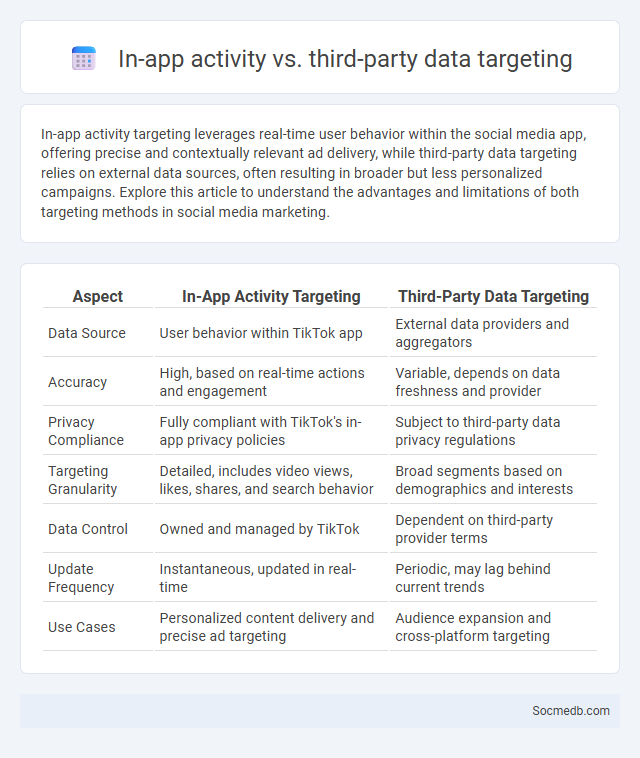
Photo illustration: In-app activity vs Third-party data targeting
In-app activity targeting leverages real-time user behavior within the social media app, offering precise and contextually relevant ad delivery, while third-party data targeting relies on external data sources, often resulting in broader but less personalized campaigns. Explore this article to understand the advantages and limitations of both targeting methods in social media marketing.
Table of Comparison
| Aspect | In-App Activity Targeting | Third-Party Data Targeting |
|---|---|---|
| Data Source | User behavior within TikTok app | External data providers and aggregators |
| Accuracy | High, based on real-time actions and engagement | Variable, depends on data freshness and provider |
| Privacy Compliance | Fully compliant with TikTok's in-app privacy policies | Subject to third-party data privacy regulations |
| Targeting Granularity | Detailed, includes video views, likes, shares, and search behavior | Broad segments based on demographics and interests |
| Data Control | Owned and managed by TikTok | Dependent on third-party provider terms |
| Update Frequency | Instantaneous, updated in real-time | Periodic, may lag behind current trends |
| Use Cases | Personalized content delivery and precise ad targeting | Audience expansion and cross-platform targeting |
Understanding In-App Activity Targeting
In-app activity targeting allows advertisers to reach specific audiences based on their interactions within a social media platform, such as likes, shares, comments, and time spent on content. Understanding these behavioral signals helps optimize your campaigns by delivering personalized ads that resonate with users' preferences and increase engagement. Leveraging in-app data effectively enhances your social media marketing strategy through precise customer segmentation and improved ad relevance.
What is Third-Party Data Targeting?
Third-party data targeting involves using consumer information collected by external sources, such as data brokers or analytics firms, to create precise audience segments for social media advertising. This data often includes demographics, behavioral patterns, and interests gathered from multiple websites and platforms beyond the advertiser's own channels. Leveraging third-party data enhances campaign effectiveness by enabling advertisers to reach users more likely to engage with their content based on broader online activity.
Defining Audience Targeting
Audience targeting in social media refers to the strategic process of identifying and reaching specific groups of users based on demographics, interests, behaviors, and geographic location. Utilizing data analytics and platform-specific tools, businesses can create personalized content and advertisements that increase engagement and conversion rates. Precise audience targeting maximizes marketing efficiency by delivering relevant messages to individuals most likely to respond.
Key Differences Between In-App and Third-Party Data
In-app data originates directly from user interactions within a specific social media platform, offering granular insights into behaviors, preferences, and engagement patterns. Third-party data is collected externally by independent providers, aggregating information from multiple sources to create broader audience profiles and market trends. While in-app data ensures high accuracy and real-time relevance, third-party data provides wider scope but often lacks detailed context and immediacy.
Benefits of In-App Activity Targeting
In-app activity targeting enables advertisers to reach users based on their specific behaviors within an application, increasing ad relevance and engagement rates. By leveraging detailed insights such as browsing history, purchase patterns, and feature usage, campaigns can be precisely tailored to user interests. This targeted approach drives higher conversion rates, improves return on ad spend (ROAS), and enhances overall marketing efficiency on social media platforms.
Limitations of Third-Party Data Targeting
Third-party data targeting on social media faces limitations due to privacy regulations like GDPR and CCPA, which restrict data collection and usage. The accuracy of third-party data can be inconsistent, leading to lower ad relevance and reduced campaign performance. Platforms increasingly prioritize first-party data, diminishing the effectiveness of third-party targeting strategies.
Enhancing Campaigns with Audience Targeting
Audience targeting in social media campaigns leverages demographic, behavioral, and psychographic data to reach the most relevant users, increasing engagement and conversion rates. By analyzing user interests and online behavior, platforms like Facebook and Instagram enable precise ad placements, optimizing your marketing budget for maximum ROI. You can significantly enhance campaign performance by continuously refining target parameters based on real-time analytics and user feedback.
Privacy Concerns and Data Compliance
Social media platforms often collect extensive personal data, raising significant privacy concerns for users. Ensuring data compliance with regulations like GDPR and CCPA is essential to protect Your information from misuse or unauthorized access. Robust privacy settings and transparent data policies help mitigate risks and enhance user trust.
Performance Metrics: Comparing Targeting Methods
Performance metrics such as click-through rates, conversion rates, and cost per acquisition are crucial in comparing social media targeting methods. Behavioral targeting often yields higher engagement, while demographic targeting provides broader reach but may lower conversion efficiency. Understanding these metrics helps you optimize social media campaigns for maximum return on investment and audience relevance.
Choosing the Right Targeting Strategy for Your Goals
Selecting the right targeting strategy for your social media campaign directly impacts your reach and engagement rates. Understanding audience demographics, interests, and behaviors allows you to tailor content that resonates with your specific goals, such as brand awareness or lead generation. Your success depends on aligning platform capabilities with precise targeting options to maximize ROI and achieve measurable results.
 socmedb.com
socmedb.com